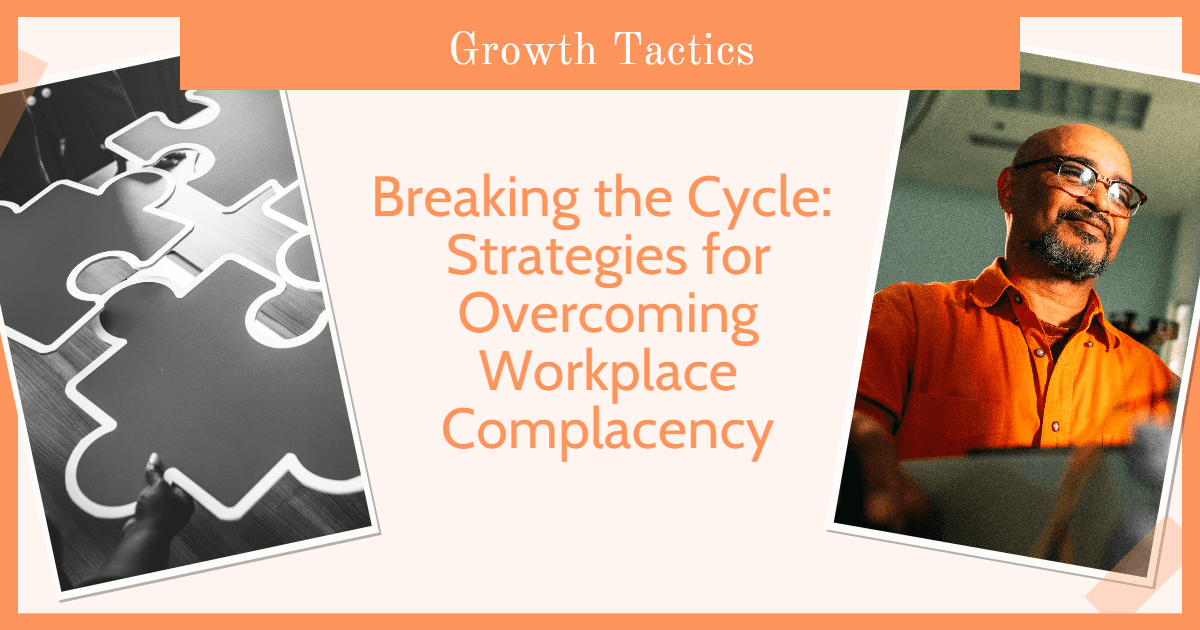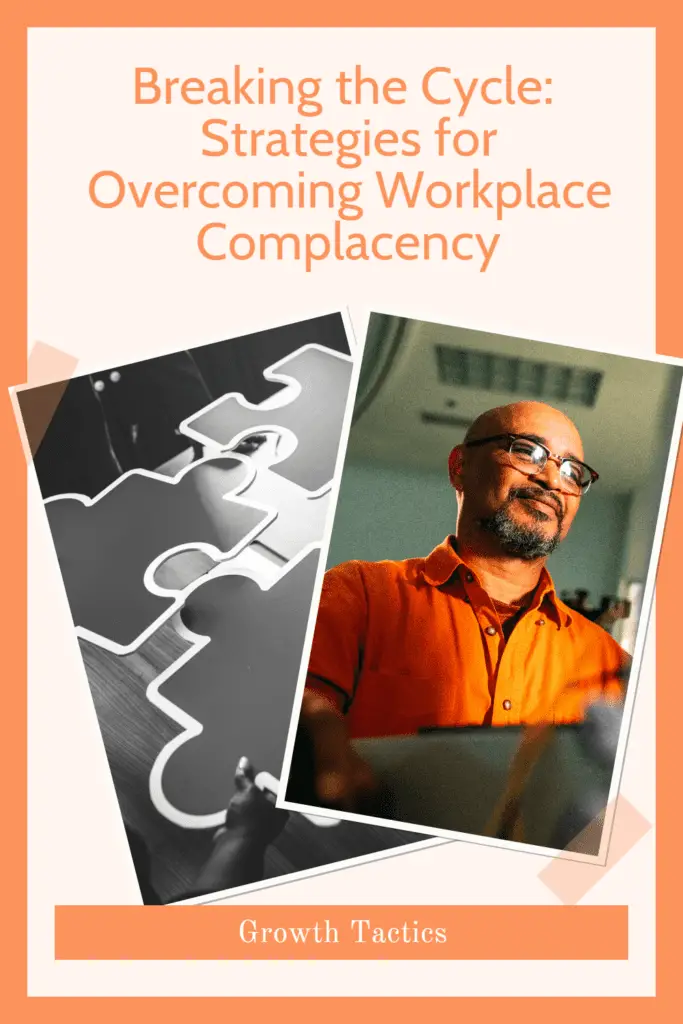Workplace complacency is a subtle but dangerous issue that can silently erode productivity, morale, and overall business success. This phenomenon occurs when employees become indifferent to their work, disengaged from their responsibilities, and resistant to change.
Breaking the cycle of complacency is crucial to fostering a culture of continuous improvement and driving long-term growth. In this article, we will explore the signs, causes, and strategies for overcoming workplace complacency.
Identifying the Signs of workplace complacency

It’s crucial to recognize the signs of complacency before it takes root in your workplace. Some common indicators include:
Lack of motivation: Employees seem uninterested in their work and have little enthusiasm for new projects or ideas.
Resistance to change: Employees are reluctant to adapt to new procedures, technologies, or strategies, often clinging to outdated methods.
Decrease in employee engagement: Employees become disengaged from their work, resulting in decreased productivity and a lack of initiative.
Stagnant skillsets and professional growth: Employees are not actively seeking opportunities for professional development or expanding their skillsets.
Causes of Complacency in the Workplace
Understanding the underlying causes of workplace complacency can help address the issue more effectively. Some common causes include:
Lack of clear goals and expectations: Employees are unsure of their objectives and the expectations placed on them, leading to confusion and disinterest.
Inadequate communication and feedback: Poor communication channels and infrequent feedback can leave employees feeling disconnected and unappreciated.
Absence of effective leadership: Leaders who fail to inspire, motivate, and guide their teams can contribute to a complacent work environment.
Insufficient recognition and rewards: A lack of acknowledgment for hard work and achievements can demotivate employees and stifle their drive for improvement.
Strategies for overcoming workplace complacency
Implementing the following strategies can help combat complacency and foster a more engaged and productive workforce:
Setting SMART goals and expectations

Setting SMART goals and expectations is a critical strategy for overcoming workplace complacency. SMART is an acronym that stands for Specific, Measurable, Achievable, Relevant, and Time-bound. Implementing SMART goals not only provides employees with clear objectives but also enhances motivation and engagement. Here’s how each component of SMART goals contributes to this process:
- Specific: Goals should be well-defined and explicit, leaving no room for ambiguity. Specific goals enable employees to understand what is expected of them, allowing them to focus their efforts effectively. Encourage employees to ask themselves questions like, “What do I want to accomplish?” and “Why is this goal important?”
- Measurable: Establishing quantifiable criteria for success is essential for tracking progress and determining when a goal has been achieved. Measurable goals enable employees to assess their performance objectively and make adjustments as needed. Consider using metrics such as numbers, percentages, or timeframes to define success.
- Achievable: While goals should be challenging, they must also be attainable. Setting unrealistic expectations can lead to frustration and demotivation. Ensure that employees have the necessary resources, skills, and support to accomplish their goals. Encourage them to break down larger goals into smaller, more manageable tasks.
- Relevant: Goals should align with the overall objectives of the organization and contribute to its long-term success. Relevant goals ensure that employees’ efforts are directed toward meaningful outcomes and foster a sense of purpose. Regularly review and update goals to ensure they remain relevant in the face of changing circumstances.
- Time-bound: Setting deadlines for goals creates a sense of urgency and encourages employees to prioritize their tasks effectively. Time-bound goals also allow for periodic evaluation and adjustment, ensuring that progress is on track and goals remain relevant.
Clearly communicating these SMART objectives to employees is essential for providing them with direction and motivation. Regularly discuss goals with team members in one-on-one meetings or team huddles, and encourage employees to share their progress and challenges. By setting SMART goals and expectations, organizations can keep employees engaged, focused, and driven to achieve success.
Improving communication and transparency
Improving communication and transparency is vital in combating workplace complacency and fostering a more engaged workforce. By encouraging open dialogue, implementing regular check-ins and feedback sessions, and utilizing effective communication tools, organizations can create a more connected and informed work environment. Here’s how each of these components can contribute to better communication and transparency:
- Encourage open dialogue: Fostering a culture of open communication where employees feel comfortable sharing their thoughts, ideas, and concerns is essential for collaboration and innovation. Establishing an environment of trust and respect allows employees to feel valued and heard, which in turn leads to increased engagement and motivation. Encourage employees to express their opinions during meetings and provide multiple channels for feedback, such as suggestion boxes or anonymous surveys.
- Implement regular check-ins and feedback sessions: Consistent and constructive feedback is crucial for employee growth and development. Schedule regular check-ins between managers and team members to discuss progress, address challenges, and provide guidance. These sessions provide an opportunity to realign goals, clarify expectations, and offer support. Additionally, encourage peer-to-peer feedback, as it can foster a sense of camaraderie and mutual support among team members.
- Utilize effective communication tools: In today’s fast-paced and often remote work environments, leveraging the right communication tools is essential for staying connected and informed. Select tools that best suit your organization’s needs, such as instant messaging platforms, video conferencing software, or project management systems. Train employees on how to use these tools effectively and encourage their adoption for both formal and informal communication.
Here are some examples of communication tools that can improve communication and transparency in remote work environments, along with their respective links:
- Instant messaging platforms:
- Video conferencing software:
- Project management systems:
To ensure that employees are using these tools effectively, consider offering training and resources on how to use them. Many of these tools also offer their own training and support resources. Encourage employees to adopt these tools for both formal and informal communication, as they can improve collaboration, transparency, and overall productivity in remote work environments.
Enhancing leadership and managerial skills

Improving leadership and management skills is crucial for organizational growth and employee satisfaction. By fostering leaders who possess strong emotional intelligence, adept listening skills, and the ability to empower and efficiently delegate tasks, a company can establish a thriving work environment that yields excellent results. Here’s how these components can be utilized to enhance leadership and management:
- Nurture leaders with robust emotional intelligence: Emotional intelligence (EQ) involves the ability to comprehend and regulate one’s own emotions, as well as those of others. Leaders with high EQ can effectively navigate interpersonal relationships, mitigate conflicts, and promote a positive work atmosphere. To build strong emotional intelligence, leaders can:
- Engage in self-reflection to understand their emotions and recognize the impact on others
- Display empathy by acknowledging and validating their team members’ emotions
- Learn to manage intense emotions and maintain composure under pressure
- Encourage active listening skills: Active listening involves fully immersing oneself in a conversation, providing undivided attention, and offering thoughtful responses. Leaders who practice active listening can build trust, obtain valuable insights, and make informed decisions. To hone active listening skills, leaders can:
- Refrain from interrupting, allowing team members to express their thoughts completely
- Paraphrase and summarize the conversation to demonstrate understanding and prevent miscommunication
- Pose open-ended questions to promote deeper discussions and gather more information
- Empower and delegate tasks efficiently: Empowering team members and effectively delegating tasks enables leaders to concentrate on strategic planning and decision-making. It also assists employees in acquiring new skills and taking responsibility for their work. To delegate tasks proficiently, leaders can:
- Clearly outline task expectations, deadlines, and desired outcomes
- Allocate tasks based on individual strengths and expertise
- Offer necessary resources, support, and autonomy, enabling team members to accomplish tasks successfully
- Monitor progress and deliver constructive feedback to promote growth and development
By refining these leadership and management skills, organizations can cultivate a more dedicated and efficient workforce. The resulting positive work environment will help attract and retain top talent, driving long-term success.
Offering recognition and rewards
Offering recognition and rewards is an essential aspect of maintaining employee satisfaction and motivation. Implementing a balanced mix of intrinsic and extrinsic rewards that cater to individual preferences can effectively acknowledge employees’ hard work and accomplishments. This approach encourages a supportive work environment and promotes employee retention. Here’s how organizations can create a comprehensive recognition and rewards system:
- Intrinsic rewards: Intrinsic rewards are intangible and stem from personal satisfaction and a sense of accomplishment. To foster intrinsic motivation, organizations can:
- Provide opportunities for personal and professional growth through training, workshops, and mentorship programs
- Encourage employees to take on challenging projects and tasks that align with their interests and passions
- Promote a culture of autonomy and trust, allowing employees to make decisions and take ownership of their work
- Offer regular, constructive feedback and celebrate small successes
- Extrinsic rewards: Extrinsic rewards are tangible items or benefits that are given as a result of employee performance. To develop a robust extrinsic rewards system, organizations can:
- Implement a competitive and fair compensation package, including salaries, bonuses, and benefits
- Offer non-monetary rewards such as flexible work hours, additional paid time off, or unique perks tailored to employees’ preferences
- Establish an employee recognition program that celebrates individual and team achievements through public acknowledgments, awards, or certificates
- Provide opportunities for career advancement and internal promotions
- Cater to individual preferences: Recognizing that employees have different preferences and values can help organizations tailor their rewards system to suit individual needs. To achieve this, organizations can:
- Conduct employee surveys to gather feedback on preferred types of rewards and recognition
- Implement a mix of formal and informal recognition practices, such as annual awards ceremonies and spontaneous acknowledgments during team meetings
- Encourage peer-to-peer recognition, empowering employees to appreciate one another’s efforts and contributions
By implementing a balanced mix of intrinsic and extrinsic rewards that cater to individual preferences, organizations can effectively acknowledge hard work and accomplishments. This approach can lead to higher employee satisfaction, increased motivation, and better overall performance.
Fostering a continuous learning and growth culture
Encouraging employees to pursue professional development opportunities is essential for organizational success and individual growth. By implementing cross-training and job rotation programs, and promoting mentorship and knowledge sharing within the organization, companies can foster a culture of continuous learning and development. Here’s how these initiatives can contribute to a more skilled and engaged workforce:
- Encourage professional development opportunities: Providing employees with opportunities to enhance their skills and knowledge can lead to increased job satisfaction, motivation, and productivity. To support professional development, organizations can:
- Offer financial assistance or reimbursements for attending workshops, conferences, or courses related to their job function
- Provide access to online learning platforms and resources for skill-building
- Encourage participation in industry events, networking groups, and professional associations
- Implement cross-training and job rotation programs: Cross-training and job rotation programs enable employees to acquire new skills and gain exposure to different roles within the organization. This promotes a more versatile and adaptable workforce. To implement these programs, organizations can:
- Identify key skills and knowledge areas that are transferable across various roles
- Develop structured cross-training plans that outline learning objectives, timelines, and expected outcomes
- Allow employees to work on diverse projects or temporarily switch roles to gain hands-on experience in different areas
- Promote mentorship and knowledge sharing: Establishing a culture of mentorship and knowledge sharing fosters collaboration, innovation, and employee development. To promote these initiatives, organizations can:
- Create formal mentorship programs that pair experienced professionals with less experienced colleagues for guidance and support
- Encourage informal mentoring relationships by creating opportunities for employees to connect and collaborate, such as through team-building activities or social events
- Implement knowledge-sharing platforms, like intranets or internal forums, where employees can share resources, best practices, and lessons learned
By encouraging employees to pursue professional development opportunities, implementing cross-training and job rotation programs, and promoting mentorship and knowledge sharing, organizations can create a culture of continuous learning and development. This leads to a more skilled, engaged, and adaptable workforce, which ultimately benefits the company’s overall success.
Measuring success and maintaining momentum

Tracking progress using key performance indicators (KPIs), celebrating successes and milestones, and addressing setbacks and challenges head-on are essential steps for maintaining momentum and driving continuous improvement within an organization. These practices foster a results-oriented culture, promote employee engagement, and contribute to the achievement of strategic goals. Here’s how organizations can effectively implement these strategies:
- Track progress using key performance indicators (KPIs): KPIs are quantifiable metrics that help organizations measure progress toward their goals and objectives. To effectively track progress using KPIs, organizations can:
- Identify relevant KPIs aligned with strategic goals and objectives, ensuring they are specific, measurable, achievable, relevant, and time-bound (SMART)
- Regularly monitor and analyze KPI data to assess performance, identify trends, and detect potential issues
- Communicate KPI results with employees and stakeholders, ensuring transparency and promoting accountability
- Celebrate successes and milestones: Acknowledging and celebrating accomplishments, both big and small, can boost employee morale and motivation. To foster a culture of recognition, organizations can:
- Implement formal recognition programs that reward outstanding performance and achievements
- Hold regular team meetings or company-wide events to acknowledge milestones and share success stories
- Encourage peer recognition, empowering employees to express gratitude and appreciation for their colleagues’ efforts
- Address setbacks and challenges head-on: Organizations inevitably encounter obstacles and setbacks. Proactively addressing these challenges and learning from them is key to maintaining momentum and driving continuous improvement. To effectively manage setbacks, organizations can:
- Develop a culture of open communication, encouraging employees to raise concerns and share challenges without fear of retribution
- Conduct regular reviews and debriefs to assess setbacks, identify root causes, and develop actionable solutions
- Use setbacks as learning opportunities, focusing on continuous improvement and fostering a growth mindset among employees
By integrating these practices into their organizational culture, companies can effectively track progress, celebrate successes, and address challenges head-on. This approach maintains momentum, drives continuous improvement, and ultimately contributes to the organization’s long-term success.
Conclusion
Breaking the cycle of workplace complacency is essential for fostering an engaged, proactive, and high-performing workforce. By implementing the strategies outlined in this article, organizations can inspire a culture of continuous improvement, innovation, and long-term success. The responsibility falls on both leaders and employees to embrace change, growth, and the pursuit of excellence.
Did you enjoy this article on workplace complacency? Please share and subscribe below.


